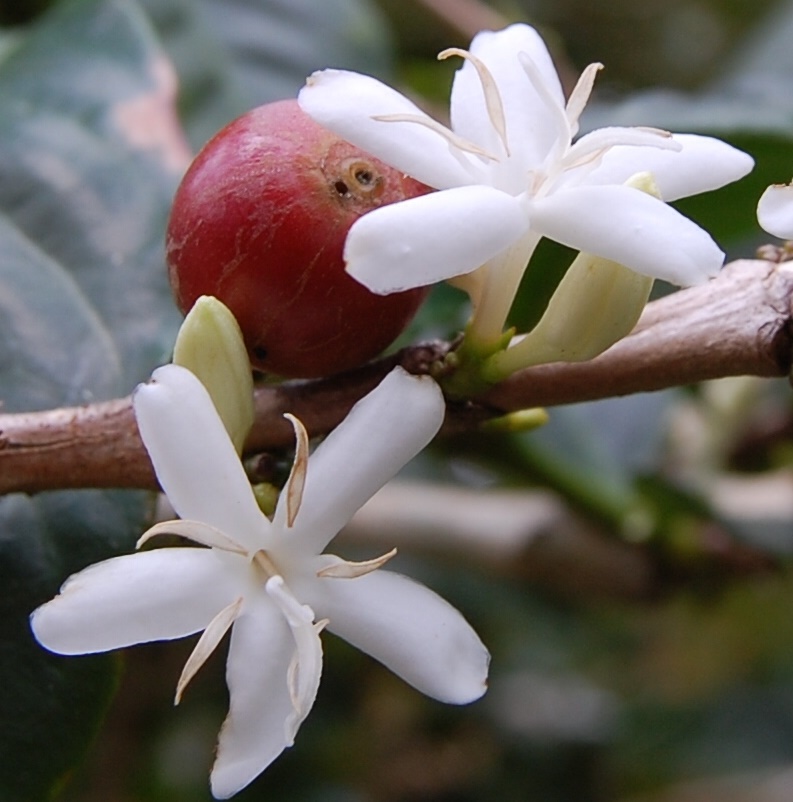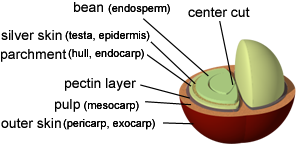What is Coffee 2025?
Everyone recognises roasted coffee beans, but you may not recognise the actual coffee plant. Source

Coffee trees are pruned short to keep them vigorous and to help with harvesting, but they can grow to heights of over 30 feet (9 metres). Each tree is covered with green waxy leaves growing opposite each other in pairs. Coffee berries grow along the branches. Because it grows continuously, it is not uncommon to see flowers, green fruit, and ripe fruit on the same tree at the same time.
Cherries mature almost a year after first flowering and take about 5 years of growth to reach full fecundity. Although coffee plants can live up to 100 years, they tend to be most productive between 7 and 20 years of age. Proper care can maintain and even increase their yields over the years, depending on the variety. The average coffee tree produces 10 pounds of coffee berries per year or 2 pounds of green beans.
All commercially grown coffee comes from a region of the world called the Coffee Belt. The trees grow best in fertile soil with moderate temperatures, frequent rainfall and shaded sun.
Botanical classification
Coffee traces its origins to a genus of plants known as Coffea. There are more than 500 genera and 6,000 species of tropical trees and shrubs in the genus. Experts estimate that there are between 25 and 100 species of coffee plants.
The genus was first described in the 18th century by the Swedish botanist Carl Linnaeus, who also described Coffea Arabica in his Species Plantarum in 1753. Since then, botanists have not agreed on an exact classification, as coffee plants can vary widely. They can range from small shrubs to tall trees, with leaves ranging in size from one to 16 inches and colours ranging from purple or yellow to a predominant dark green.
There are two important types of coffee in the commercial coffee industry, Arabica and Robusta.
Coffea Arabica - C. Arabica
Varieties: Bourbon, Typica, Caturra, Mundo Novo, Tico, San Ramon, Jamaican Blue Mountain
Coffea Arabica comes from the original coffee trees found in Ethiopia. These trees produce fine, mild, flavourful coffee and account for approximately 70% of the world's coffee production. The beans are flatter and more elongated than Robusta and contain less caffeine.
Arabica has the highest prices on the world market.The best Arabica varieties are grown between 2,000 and 6,000 feet (610 to 1,830 metres) above sea level, although the optimum altitude depends on proximity to the equator.
The most important factor is that temperatures should remain moderate, ideally 59 to 75 degrees Fahrenheit, with about 60 inches of rainfall per year. The trees are hardy, but a hard frost will kill them.
Arabica trees are expensive to grow because the ideal terrain is usually steep and access is difficult. Also, because the trees are more susceptible to disease than Robusta, they require extra care and attention.
Coffea canephora - C. canephora var. Robusta
Variety: Robusta
Most of the world's Robusta is grown in Central and West Africa, parts of South East Asia including Indonesia and Vietnam, and Brazil. Robusta production is growing, although it only accounts for about 30% of the world market.
Robusta is mainly used in blends and for instant coffee. The Robusta bean itself tends to be slightly rounder and smaller than the Arabica bean.
Robusta wood is stronger and more resistant to disease and parasites, making it easier and cheaper to grow. It also has the advantage of being able to tolerate warmer climates, preferring a constant temperature of 75 to 85 degrees Fahrenheit, allowing it to grow at much lower altitudes than Arabica.
It requires about 60 inches of rainfall per year and cannot withstand frost. Compared to Arabica, Robusta beans produce coffee that has a distinctive flavour and about 50-60% more caffeine.
Anatomy of the coffee berry
The beans you brew are actually the processed and roasted seeds from a fruit called the coffee berry.
The outer shell of the coffee berry is called the exocarpy. Underneath it is mesocarpy, a thin layer of pulp, followed by a mucous layer called the parenchyma. The beans themselves are covered with a paper-like shell called a endocarpymore commonly referred to as parchment.
Inside the parchment, two beans lie side by side, each covered by another thin membrane. The biological name for this seed coat is. spermodermbut in the coffee trade it's usually referred to silver rind.

In about 5% of the world's coffees, there is only one bean inside the berry. This is called a piberry (or caracol or "snail" in Spanish), and it is a natural mutation. Some people believe that pibberries are actually sweeter and more flavourful than standard grains, so they are sometimes hand-sorted for special sale.